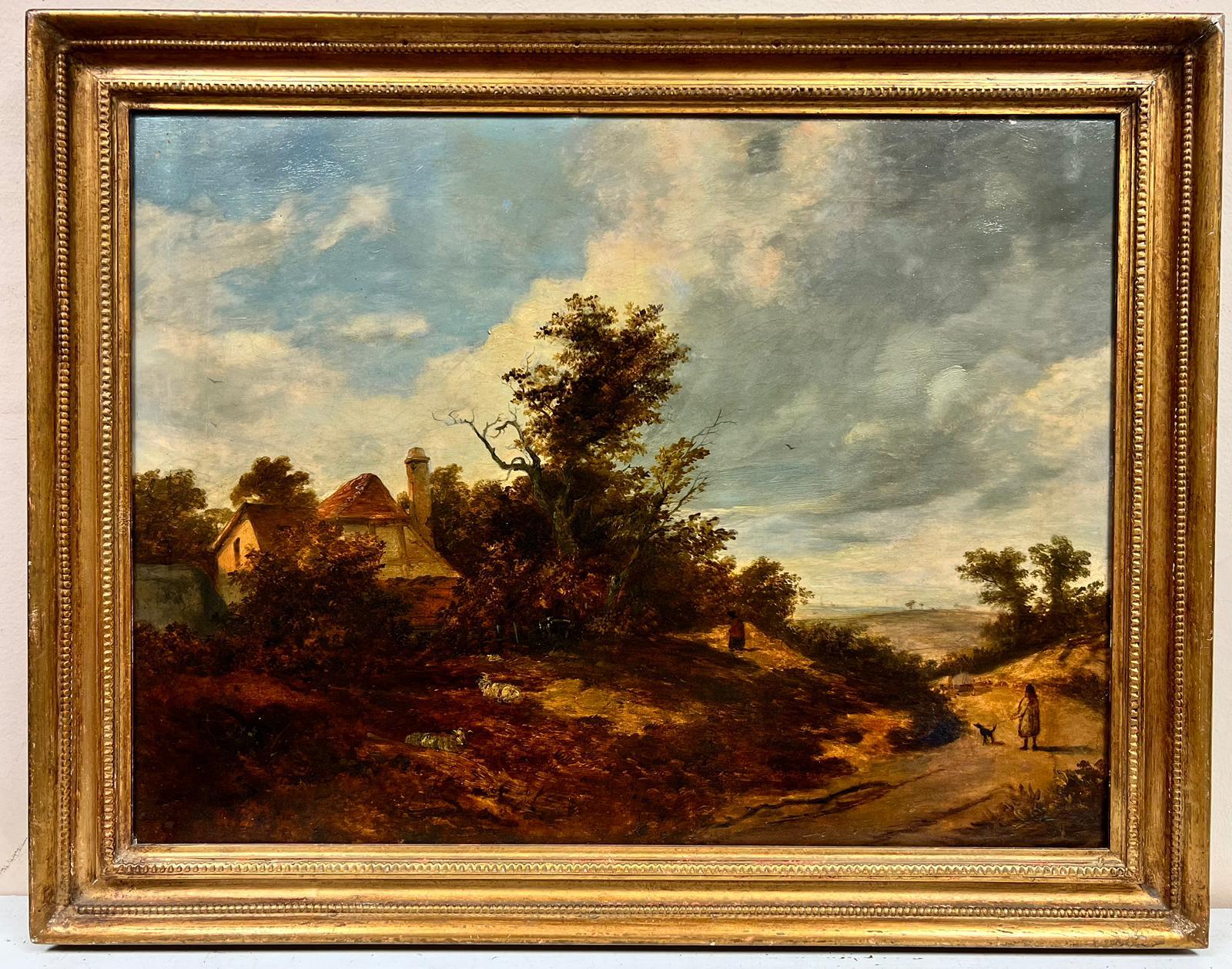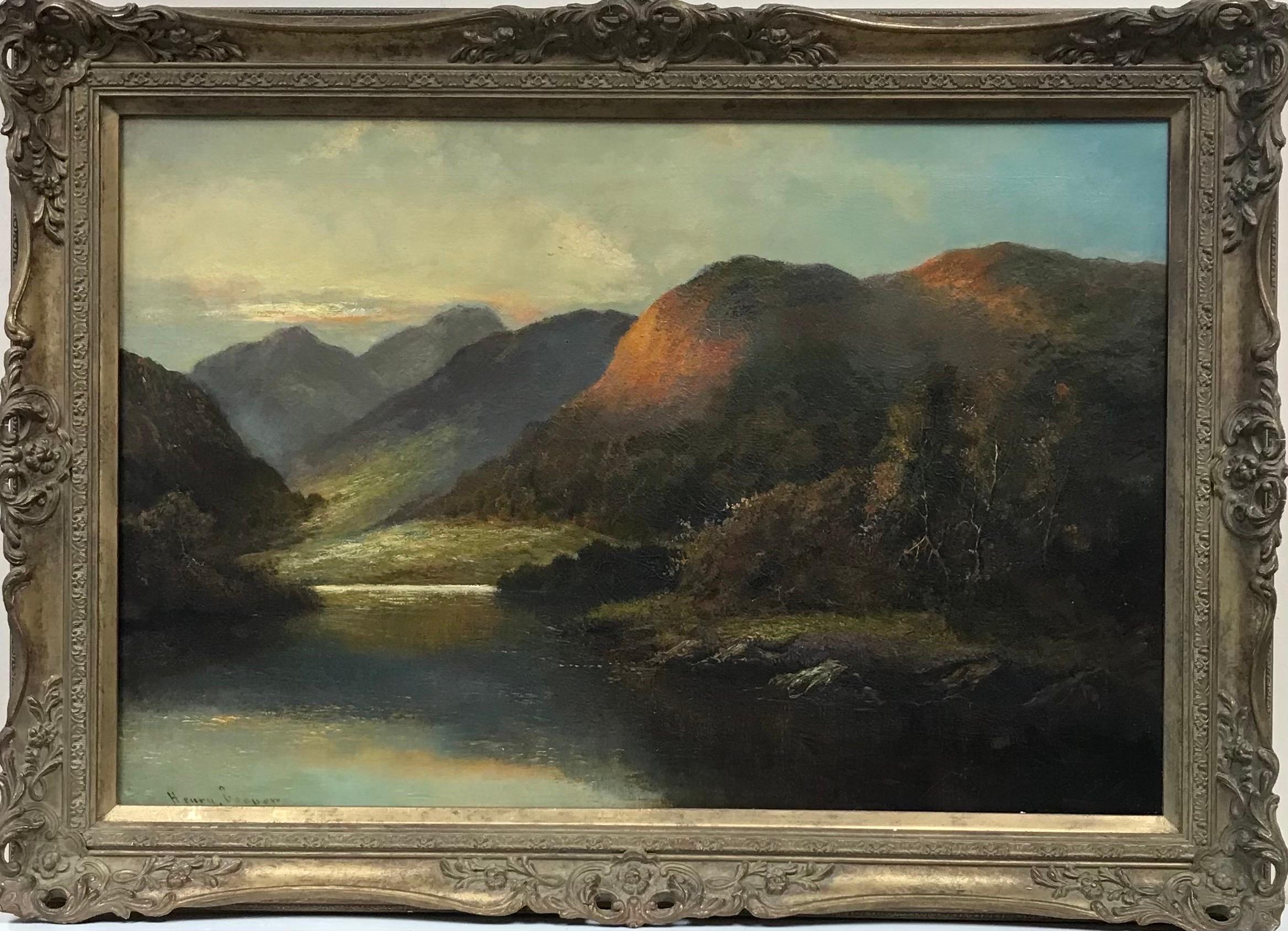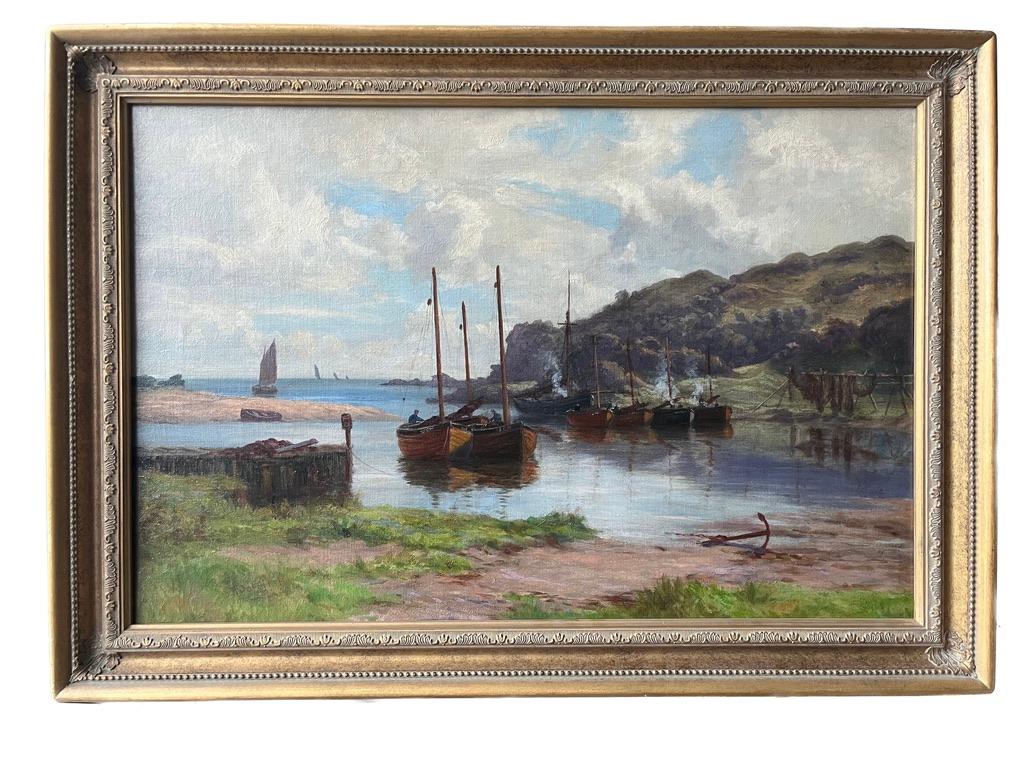Items Similar to 19th Century English Coaching Scene Oil Painting Horse Carriages outside Tavern
Want more images or videos?
Request additional images or videos from the seller
1 of 13
Victorian English Oil 19th Century English Coaching Scene Oil Painting Horse Carriages outside Tavern
About the Item
The Half Way Hotel
English artist, late 19th century
(double sided painting with a hunting scene to the reverse).
oil painting on board, unframed
board: 13 x 10.75 inches
provenance: private collection, Surrey, England
condition: good and sound condition, a few specks of paint loss and minor surface scuffs.
The Victorian Coaching Inn
During the Victorian era in the United Kingdom (1837-1901), traveling was a different experience altogether. Imagine a time when horse-drawn stagecoaches ruled the roads, and the journey was just as important as the destination. At the heart of this era were the iconic Victorian coaching inns, which played a vital role in accommodating travelers and providing essential services along the bustling coaching routes.
A Glimpse into History
Victorian coaching inns were not just places to rest; they were vibrant hubs of activity and community. Situated strategically along major travel routes or at crossroads, these inns were imposing structures designed to cater to both human and equine needs. The architecture often featured grand facades and central courtyards where weary travelers and their horses could find respite.
Services Offered
Step inside a Victorian coaching inn, and you'd discover a world of services tailored to the needs of travelers. Lodging was available for those seeking overnight stays, ranging from basic rooms to more comfortable accommodations for wealthier guests. Meals served were hearty and comforting, showcasing traditional British fare like roast meats, pies, and stews. The inns also provided stabling and fodder for horses, crucial for the smooth operation of stagecoach travel.
Beyond Practicality: Social Hubs
More than just a place to eat and sleep, coaching inns were social centers where people from all walks of life converged. Travelers mingled with locals, exchanging stories and news from distant places. It was here that friendships were forged and business deals sealed over a pint of ale or a warm meal.
The Rise and Fall
The decline of Victorian coaching inns came with the advent of the railways, which offered faster and more reliable transportation. As rail networks expanded, stagecoach travel became obsolete, leading to the eventual demise of many coaching inns. However, their legacy lives on in the form of converted hotels, restaurants, and museums that preserve their unique charm and historical significance.
Exploring Today
Today, if you venture into the British countryside, you may stumble upon a beautifully restored coaching inn, now serving as a quaint hotel or a cozy restaurant. These establishments evoke a sense of nostalgia for a bygone era, inviting visitors to step back in time and experience the romance of Victorian travel.
- Creator:Victorian English Oil
- Dimensions:Height: 13 in (33.02 cm)Width: 10.75 in (27.31 cm)
- Medium:
- Movement & Style:
- Period:
- Condition:
- Gallery Location:Cirencester, GB
- Reference Number:1stDibs: LU509314323382

About the Seller
5.0
Platinum Seller
These expertly vetted sellers are 1stDibs' most experienced sellers and are rated highest by our customers.
Established in 1989
1stDibs seller since 2016
3,570 sales on 1stDibs
Typical response time: 2 hours
- ShippingRetrieving quote...Ships From: Cirencester, United Kingdom
- Return PolicyA return for this item may be initiated within 3 days of delivery.
More From This SellerView All
- 1830's English Oil Storm Clouds Norfolk Landscape Norwich Cathedral River YareBy (Circle of) John ConstableLocated in Cirencester, GloucestershireStorm Clouds over the River Yare *see notes below English School, circa 1830's circle of John Constable (English 1776-187) oil painting on canvas, framed canvas: 18 x 25 inches condi...Category
Early 19th Century Victorian Landscape Paintings
MaterialsCanvas, Oil
- Fine 1830s English Rural Landscape Large Oil Painting Figures with Dog & CottageLocated in Cirencester, GloucestershireArtist/ School: English School, circa 1830's, follower of John Constable Title: The Rural Lane Medium: oil on canvas, framed Framed: 22 x...Category
Early 19th Century Victorian Landscape Paintings
MaterialsCanvas, Oil
- Fine Large Victorian Oil Painting Scottish Loch Scene & Mountains at SunsetLocated in Cirencester, GloucestershireArtist/ School: British School, late 19th century, signed Title: Sunset in the Scottish Highlands Medium: oil on canvas Framed: 25 x 35 inches Canvas: 20 x 30 inches Provenance: ...Category
19th Century Victorian Landscape Paintings
MaterialsOil, Canvas
- Fine Early 1800's Scottish Pastoral Landscape Ancient Castle Figures & SheepLocated in Cirencester, GloucestershireArtist/ School: Scottish School, early 19th century Title: a large panoramic Scottish landscape, with ancient castle standing to the centre, with various figures enjoying the landsc...Category
Early 19th Century Victorian Landscape Paintings
MaterialsOil
- 19th Century French Signed Oil, Fishing Folk on the Shore at Sunrise by BoatsLocated in Cirencester, GloucestershireArtist/ School: French School, 19th century, indistinctly signed lower right corner. Title: Sunrise on the Beach Medium: signed oil painting on canvas, framed. framed size: 18 x...Category
19th Century Victorian Landscape Paintings
MaterialsOil
- Victorian Oil Painting Barge Boats by Pastoral River Sunset Cattle GrazingLocated in Cirencester, GloucestershireArtist/ School: 19th Century English School Title: Barges In A River Landscape at Sunset, Cattle resting in pastoral landscape Medium: o...Category
19th Century Victorian Landscape Paintings
MaterialsOil
You May Also Like
- David with the Head of Goliath, 19th Century Victorian OilBy John Rogers HerbertLocated in London, GBJohn Rogers Herbert RA 1810- 1890 Oil on canvas, dated '1850' lower right on sword strap Image size: 33 ½ x 23 ½ inches Gilt Watts frame This striking painting, depicts David as a y...Category
1850s Victorian Figurative Paintings
MaterialsOil
- Victorian landscape painting of Scottish fishing boats moored in a bayLocated in Harkstead, GBA very tranquil scene of fishing boats moored in harbour with a sunlit sea beyond. Painted with a most attractive palette of blues and greens and with a pleasing composition that le...Category
19th Century Victorian Landscape Paintings
MaterialsOil, Canvas
- Antique 19th century English fishing vessels In the English ChannelBy William Henry WilliamsonLocated in Woodbury, CTAntique 19th century English fishing vessels In the English Channel William Henry Williamson was a gifted, London painter of coastal scenes, ...Category
1880s Victorian Figurative Paintings
MaterialsOil, Canvas
- Cornish Fisherwoman with Net, Victorian Painting by D.W. HaddonBy David W. HaddonLocated in Long Island City, NYA late Victorian period painting by British artist, David W. Haddon, active (1884-1914). The canvas measures 20 x 14 inches and is signed low...Category
Late 19th Century Victorian Figurative Paintings
MaterialsOil, Canvas
- 19th Century genre oil painting of children gathering berriesBy William BromleyLocated in Nr Broadway, WorcestershireWilliam Bromley British, (1816-1890) Gathering Hawthorn Berries Oil on canvas, signed Image size: 27.5 inches x 35.5 inches Size including frame: 33.5 inches x 41.5 inches A love...Category
19th Century Victorian Figurative Paintings
MaterialsCanvas, Oil
- 19th Century seascape oil painting of Douglas Harbour, Isle of ManBy William Edward WebbLocated in Nr Broadway, WorcestershireWilliam Edward Webb British, (1862-1903) Douglas Harbour, Isle of Man Oil on canvas, signed Image size: 21.5 inches x 37.5 inches Size including frame: 33 inches x 49 inches A busy quayside painting by William Edward Webb of Douglas Harbour on the Isle of man. Fishermen in boats can be seen preparing to head ashore as other figures make their way along the quayside. William Edward Webb was born in Cheltenham, Gloucestershire in 1862 to William Benjamin Webb and Ellen Butler. His father was a printer and an artist and it is highly likely he received tuition from him. Following the death of his mother, his father remarried and moved the family to Manchester sometime after 1871. By the 1880’s, Webb had started working as an artist and later set up a studio at 30 Exchange Buildings in Manchester. He began exhibiting at the Manchester City Art Gallery from 1890, where he showed more than 60 paintings during his lifetime. He also exhibited at the Royal Academy and Walker Art Gallery Liverpool from 1892. He married Clara Foster in 1899 and the couple lived at 1 Sylvan Grove, Chorlton Upon Medlock in South Manchester with their daughter Florrie. He became friends with the artist Walter Emsley (1860-1938) who also lived in Manchester. Although he spent the rest of his life in Manchester, Webb travelled throughout the UK painting coastal and marine scenes around the main ports and harbours. He spent a great deal of time in the Isle of Mann painting numerous scenes along the coast including views of Peel and Douglas Harbour, subjects he frequently returned to. Webb painted in a highly distinctive style; loose and informal but which manages to retain the sense of perspective. He struggled with ill health and depression throughout his life which sadly led to his suicide 9 November, 1903. In 1974, a retrospective exhibition was held at The Old Customs House and Old Solent House in Lymington, which brought a new found interest in his work. His paintings are now highly sought after and are represented in many collections and Museums including the Astley Hall...Category
19th Century Victorian Landscape Paintings
MaterialsCanvas, Oil
Recently Viewed
View AllMore Ways To Browse
Antique Victorian
Antique English
Victorian Collection
Painted Victorian
English Warming
19th Oil British
Victorian Museum
19th Century British Oil
British Oil Paintings 19th Century
19th Century English Oil Painting
English Victorian Painting
19th Century Art Horses
Reverse Painted Scene
19th Century Oil Painting England
British Victorian Oil Painting
English Horse
Victorian English Oil
1901 Oil





